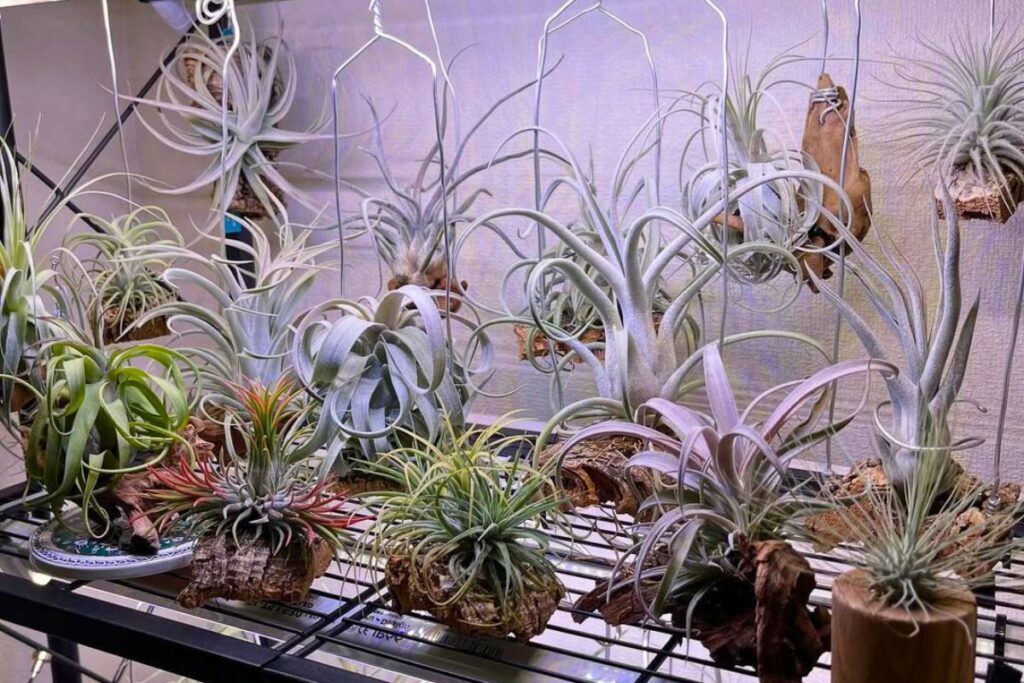Air plants, also known as Tillandsia, are fascinating and unique houseplants that thrive without the need for soil. These versatile plants draw nutrients and moisture from the air through their leaves, making them a perfect choice for creative and low-maintenance indoor gardening. In this guide, we’ll explore everything you need to know to successfully grow and care for air plants indoors.

Contents
Choosing the Right Location
Air plants thrive in bright, indirect light. While they can tolerate some direct sunlight, too much can cause their leaves to dry out and scorch. Place your air plants near a window where they can receive plenty of filtered sunlight or in a well-lit room. If natural light is limited, you can use a grow light to provide the necessary illumination. Aim for about 4-6 hours of bright, indirect light daily to ensure healthy growth.
Maintaining Proper Temperature and Humidity
Air plants prefer warm and humid environments, similar to their native tropical habitat. Keep your plants in a room with temperatures ranging from 50-90°F (10-32°C). Avoid placing them near drafty windows or heating vents, as sudden temperature fluctuations can stress the plants. To maintain humidity, mist the leaves regularly or place your air plants in a room with a naturally higher humidity level, such as a bathroom or kitchen.
Watering Wisely
Proper watering is crucial for the health of your air plants. While they don’t require soil, they do need regular hydration. There are two primary methods for watering air plants:
Soaking
- Submerge the air plants in a bowl of room-temperature water for 20-30 minutes every 1-2 weeks.
- After soaking, gently shake off excess water and place the plants upside down on a towel to dry completely before returning them to their display.
Misting
- Lightly mist your air plants 2-3 times a week, ensuring they receive a thorough but gentle misting.
- If you live in a particularly dry environment, increase the frequency of misting to keep the plants hydrated.
Be sure to adjust your watering schedule based on your home’s humidity and the specific needs of your air plants.
Fertilizing Air Plants
While air plants don’t require frequent fertilizing, providing them with occasional nutrients can encourage growth and blooming. Use a water-soluble fertilizer formulated for bromeliads or air plants, diluted to half strength. Apply the fertilizer once a month during the growing season by either adding it to the soaking water or misting solution.
Pruning and Maintenance
Air plants require minimal pruning, but you can trim away any dead or discolored leaves to keep the plants looking their best. Use clean, sharp scissors to make clean cuts and minimize damage to the plants. Additionally, remove any spent blooms to encourage new growth and maintain the plant’s overall health.
Styling Your Air Plants
Air plants are incredibly versatile and can be styled in various creative ways to enhance your indoor decor. Here are some ideas to help you create a stunning display:
- Hanging Planters: Use decorative hanging planters or glass orbs to showcase your air plants. This not only saves space but also adds a dynamic, vertical element to your decor.
- Terrariums: Create a miniature garden by arranging air plants with other decorative elements such as stones, moss, and driftwood in a glass terrarium.
- Wall Displays: Attach air plants to a piece of driftwood, a wire frame, or a decorative wall hanger to create a living wall display.
- Tabletop Arrangements: Place air plants in small decorative bowls, trays, or shells to create a charming tabletop accent.
- Creative Containers: Use unique and unconventional containers such as seashells, geodes, or even repurposed household items to display your air plants.
Propagation Techniques
Air plants reproduce through offsets, also known as pups, which grow at the base of the parent plant. Here are the steps to propagate air plants:
- Wait until the pups are at least one-third the size of the parent plant before removing them.
- Gently separate the pups from the parent plant using clean, sharp scissors.
- Allow the cut ends to dry for a few hours before placing the pups in their new display.
By following these steps, you can expand your air plant collection or share them with friends and family.
Dealing with Pests and Diseases
Air plants are relatively resistant to pests and diseases, but they can occasionally fall victim to mealybugs or scale insects. Regularly inspect your plants for signs of pests and treat any infestations promptly with insecticidal soap or neem oil. Maintaining proper care practices and a clean environment can help prevent most common issues.
Troubleshooting Common Issues
- Brown Leaf Tips: This can indicate low humidity or underwatering. Increase humidity levels and adjust your watering schedule.
- Curling Leaves: This can be a sign of dehydration. Increase the frequency of soaking or misting.
- Rotting: Overwatering or inadequate drying can lead to rot. Ensure your plants dry completely after soaking or misting and adjust your watering routine.
Growing air plants indoors can be a rewarding experience, adding a touch of uniqueness and elegance to your home. By following these care tips and paying attention to your plants’ needs, you’ll be well on your way to enjoying a lush and healthy collection of air plants. Happy planting!
